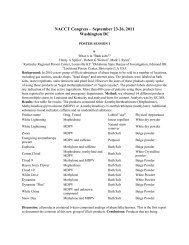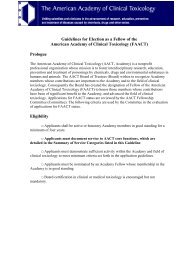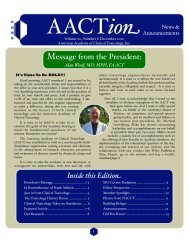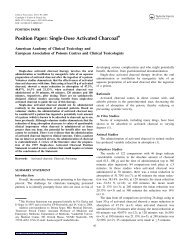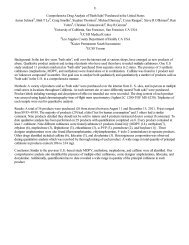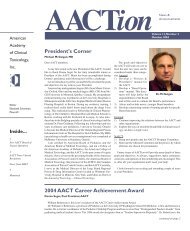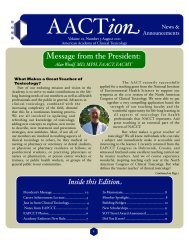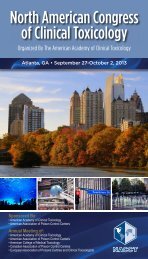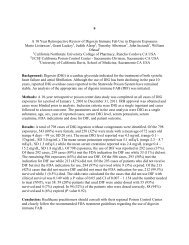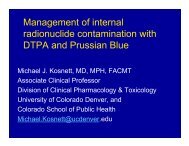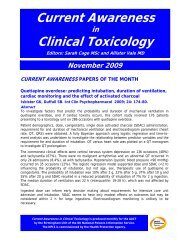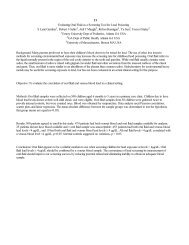Posters IV - The American Academy of Clinical Toxicology
Posters IV - The American Academy of Clinical Toxicology
Posters IV - The American Academy of Clinical Toxicology
Create successful ePaper yourself
Turn your PDF publications into a flip-book with our unique Google optimized e-Paper software.
area. Among exposures, the two most common substance categories were cosmetics and analgesics in all<br />
groups except Pacific Islander, where foreign body was the second most common substance category.<br />
Unintentional exposure was the most common reason and children 0-5 years age the most common age<br />
group. This was the same amongst all races and ethnicities and consistent with national data. Of the top 25<br />
exposures, 70% <strong>of</strong> patients were White; about 25% Black. Suspected suicide accounted for 70% <strong>of</strong><br />
intentional exposures amongst Blacks and 55% in Whites. Blacks represented 15% <strong>of</strong> all bites and stings<br />
compared to 82% Whites. Of mushroom exposures, Whites accounted for 80% <strong>of</strong> the exposures followed<br />
by Pacific Islanders at 20%. Conclusions: <strong>The</strong>re was little difference in the racial and ethnic composition<br />
<strong>of</strong> our two most common substance categories, reason for exposure, and age groups. It is feasible and<br />
valuable to collect racial and ethnic data to further identify, address, and prevent potential disparities in<br />
poison injuries.<br />
297<br />
Tox Toolbox: an app for iPhone, iPad, and Android<br />
Rais Vohra 2 , John H Trestrail III 1<br />
1 Center for the Study <strong>of</strong> Criminal Poisoning, Los Lunas NM 2 UCSF-Fresno Medical Center, Fresno CA<br />
Background: Tox Toolbox is a clinical toxicology s<strong>of</strong>tware application ("app") for iPhone, iPad, and<br />
Android smartphones. This program is designed to be used by healthcare workers and as a board-review<br />
resource for commonly tested toxicology topics. We authored the fixed clinical contents, and in January<br />
2011, the 1.0 version became available for online purchase and download. Four months later, a companion<br />
version <strong>of</strong> the s<strong>of</strong>tware was released for use on Android smartphones. Featured app contents include:<br />
PCC call button; toxic syndrome assessment; decontamination techniques and indications; essential<br />
management for 25 common overdoses; direct links to PCC homepages, pill identification sites, and other<br />
websites for envenomations, plant/mushroom identification, and veterinary poisonings; and a "Tox<br />
History Calendar," featuring notable or infamous moments from toxicology history. Detailed descriptions<br />
and screenshots <strong>of</strong> the app can be viewed here: http://itunes.apple.com/us/app/toxtoolbox/id412067576?mt=8<br />
Methods Vendor data accessed from the iTunes App Store, a division <strong>of</strong><br />
Apple Inc (Cupertino, CA). We collated weekly information statistics about the number <strong>of</strong> app downloads,<br />
and their country <strong>of</strong> origin. Results <strong>The</strong>re were 251 downloads to 25 countries in the first 3 months after<br />
the app's release. Countries <strong>of</strong> download included the following (in descending order <strong>of</strong> the number <strong>of</strong><br />
downloads): USA, Great Britain, Australia, Canada, Switzerland, Mexico, South Africa, New Zealand,<br />
Germany, Hungary, Italy, Saudi Arabia, Sweden, and Taiwan; these were collectively responsible for 241<br />
<strong>of</strong> the total downloads. Ten other countries had one download each. Conclusions Since their inception,<br />
poison control centers have successfully incorporated emerging communications platforms. In the current<br />
era, app s<strong>of</strong>tware featuring instant, handheld access to the basics <strong>of</strong> clinical toxicology management<br />
provides new opportunities for toxicologists to connect with clinical workers as well as with the general<br />
public. Our experience confirms that app s<strong>of</strong>tware is a viable modality for clinical toxicology education<br />
and outreach efforts. <strong>The</strong> distribution <strong>of</strong> these unsolicited app subscribers spanned 25 countries. <strong>The</strong>se<br />
first users, the so-called "early adopters" in the infotech nomenclature, are crucial to the emergence and<br />
success <strong>of</strong> new media and technologies. Our data indicate that there is a broad geographic demand for<br />
toxicology-related apps. App s<strong>of</strong>tware promises to generate many new tools for education, outreach and<br />
surveillance, and research. However, further analysis, user feedback, and research about this powerful new<br />
communications tool are needed to explore the full costs, benefits, and limitations <strong>of</strong> these products.<br />
298



